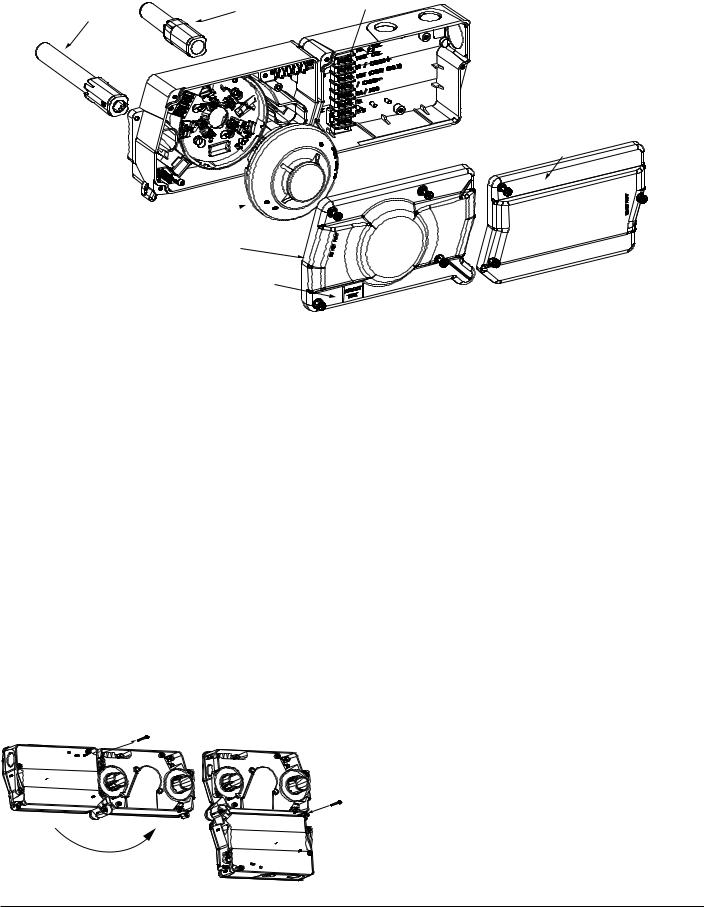System Sensor D2 User Manual

INSTALLATION AND MAINTENANCE INSTRUCTIONS
|
|
|
3825 Ohio Avenue, St. Charles, Illinois 60174 |
||
D2 Duct Smoke Detector |
|
1-800-SENSOR2, FAX: 630-377-6495 |
|||
|
|
www.systemsensor.com |
|||
Specifications |
|
|
|
|
|
Operating Temperature: |
–4° to 158° F (–20° to 70° C) |
|
|
|
|
Storage Temperature: |
–22° to 158° F (–30° to 70° C) |
|
|
|
|
Humidity: |
0% to 93% Relative Humidity Non-condensing |
|
|
||
Air Velocity: |
100 to 4000 ft./min. (0.5 to 20.3 m/sec.) |
|
|
|
|
Rectangular Footprint Dimensions: |
14.38 in L x 5 in W x 2.5 in D (37 cm L x 12.7 cm W x 6.36 cm D) |
|
|
||
Square Footprint Dimensions: |
7.75 in L x 9 in W x 2.5 in D (19.7 cm L x 22.9 cm W x 6.35 cm D) |
|
|
||
Weight: |
1.8 pounds; 0.82 kg |
|
|
|
|
Electrical |
|
|
|
|
|
Power supply voltage: |
8.5-35 VDC |
|
|
|
|
Input capacitance: |
0.1 µF max. |
|
|
|
|
Reset Voltage: |
2.5 VDC min. |
|
|
|
|
Reset Time (with RTS451/RTS151): |
.03 to 0.3 sec. |
|
|
|
|
ACCESSORY CURRENT LOADS AT 24 VDC |
|||||
Reset Time (by power down): |
0.3 sec. max. |
||||
DEVICE |
STANDBY |
ALARM |
|||
Power Up Time: |
35 sec. max. |
||||
Alarm response time: |
15 sec. |
RA400Z/RA100Z |
0mA |
12mA Max. |
|
Sensitivity Test: |
See detector label |
RTS451/RTS151 |
0mA |
12mA Max. |
|
Current Requirements (Using No Accessories) |
RTS451KEY/RTS151KEY |
0mA |
12mA Max. |
||
Peak standby current |
120µA |
||||
|
|
|
|||
Average standby current |
60µA |
|
|
|
|
Max. alarm current |
130 mA |
|
|
|
|
Table of Contents |
|
|
|
|
|
|
|
Page |
|
[1] Limitations of Duct Smoke Detectors. . |
. . |
. |
. |
. |
. . . |
. |
. |
. |
1 |
[2] General Description . . . . . . . . |
. . |
. |
. |
. |
. . . |
. |
. |
. |
1 |
[3]Contents of the Duct Smoke Detector Kit. . . . . . . . . . . .1
[4]Exploded View of Duct Smoke Detector Components. . . . . . . 2
[5] Detector Installation. . . . . . . . . . . . . . . . . . . 2 [6] Sampling Tube Installation . . . . . . . . . . . . . . . . .3
[7] Measurement Tests. . . . . . . . . . . . . . . . . . . |
|
.3-4 |
|||
[8] Field Wiring. . . . . . . . . . . . . . . . . . . . . . |
|
4 |
|||
[9] Detector Status Indicator . |
. . . . . . . . . . . . . . . . |
|
4 |
||
[10] Verification of Operator. |
. . . . . . . . . . . . . . . . |
|
.5 |
||
[11] Dectector Cleaning Procedures.. . . . . . . . . . . . . . |
|
5 |
|||
[12] Sensor Replacement. . |
. . . . . . . . . . . . . . . . |
|
.6 |
||
[13] Optional Accessories. . . . . . . . . . . . . . . . . . |
. |
6 |
|||
Wiring Diagrams. . |
. . . . . . . . . . . . . . . . . . . |
|
.4,6 |
||
Warranty |
. . . . . . . . . . . . . . . . . . . . . . |
. |
6 |
||
The D2 model is a photoelectric detector approved for an extended air speed range of 100 to 4000 feet per minute (0.5 m/s to 20.3 m/s) and an operational temperature range of −4°F to 158°F (−20°C to 70°C).
Before Installing
Read the System Sensor Guide for Proper Use of Smoke Detectors in Duct Applications (A05-1004), which provides detailed information on detector spacing, placement, zoning, wiring, and special applications. Copies of this manual are available online at www.systemsensor.com. NFPA Standards 72 and 90A should also be referenced for detailed information.
NOTICE: This manual shall be left with the owner/user of this equipment. IMPORTANT: This detector must be tested and maintained regularly following NFPA 72 requirements. The detector should be cleaned at least once a year.
[1] Limitations Of Duct Smoke Detectors

 WARNING
WARNING
The National Fire Protection Association has established that DUCT DETECTORS MUST NOT BE USED AS A SUBSTITUTE FOR OPEN AREA DETECTOR PROTECTION as a means of providing life safety. Nor are they a substitute for early warning in a building’s regular fire detection system.
System Sensor supports this position and strongly recommends that the user read NFPA Standards 90A, 72, and 101. The D2 Air Duct Smoke Detectors are listed per UL 268A.
This device will not operate without electrical power. Fire situations may cause an interruption of power. The system safeguards should be discussed with your local fire protection specialist.
This device will not sense smoke unless the ventilation system is operating and the cover is installed.
For this detector to function properly, it MUST be installed according to the instructions in this manual. Furthermore, the detector MUST be operated within ALL electrical and environmental specifications listed in this manual. Failure to comply with these requirements may prevent the detector from activating when smoke is present in the air duct.
[2] General Description
Smoke introduced into the air duct system will be distributed throughout the entire building. Smoke detectors designed for use in air duct systems are used to sense the presence of smoke in the duct.
Model D2 Duct Smoke Detector utilizes photoelectric technology for the detection of smoke. This detection method, when combined with an efficient housing design, samples air passing through the duct allowing detection of a developing hazardous condition. When sufficient smoke is sensed, an alarm signal is initiated and appropriate action can be taken to shut off fans, blowers, change over air handling systems, etc. These actions can facilitate the management of toxic smoke and fire gases throughout the areas served by the duct system.
[2.1] DETECTOR FEATURE SET
-Utilizes 2151 plug-in head
-Sampling tubes installed from front or rear
-Compatible with existing accessories
[3] Contents Of The Duct Smoke Detector Kit
1.Sensor/power board assembly and covers
2.Three #10 sheet metal screws for mounting
3.Drilling template
4.One sampling tube end cap
5.One plastic exhaust tube
NOTE: A sampling tube must be ordered to complete the installation. It must be the correct length for the width of the duct where it will be installed. See Table 1 on page 3 to determine the inlet tube required for different duct widths.
SS-300-014 |
1 |
I56-3050-004R |
004R-3050-I56

[4] Figure 1. Exploded View of Duct Smoke Detector Components:
SAMPLING TUBE |
EXHAUST TUBE |
WIRING TERMINALS |
(sold seperately) |
|
|
TERMINAL HOUSING
MODULE COVER
SENSOR HEAD 
SENSOR MODULE COVER
MAGNET TEST LOCATION
[5] Detector Installation
[5.1] Verify Duct Air Flow Direction And Velocity
Model D2 detectors are designed to be used in air handling systems having air velocities of 100 to 4000 feet per minute. Duct widths from 6 inches to 12 feet can be accommodated. Be sure to check engineering specifications to ensure that the air velocity in the duct falls within these parameters. If necessary, use a velocity meter (anemometer) to check the air velocity in the duct.
[5.2] Determine Mounting location and Configuration
On ducts wider than 18 inches it is recommended that the detector be mounted downstream of a bend, obstruction in the duct, or the supply or return air inlet.
Exception: Installation of duct detectors can be on or within a commercial packaged rooftop heating and air-conditioning system, fire/smoke dampers and economizers. They may be mounted in either the supply and/or return air section as determined by local code.
Once a suitable location is selected, determine if the detector is to be mounted in a side-by-side “rectangular” configuration or a top-over-bottom “square” configuration as shown in Figure 2. If mounting in the square configuration, remove the rear attachment screw, rotate the unit at hinge, and replace the screw into the new attachment hole as shown in Figure 2. Do NOT remove the hinge screw during this process. Final installation approval shall be based upon passing section 10.4.2 and 10.4.4 tests.
Figure 2:
H0574-05
[5.3] Drill the Mounting Holes
Remove the paper backing from the mounting template supplied. Affix the template to the duct at the desired mounting location. Make sure the template lies flat and smooth on the duct.
[5.3.1] For rectangular side-by-side mounting configuration:
Center punch at (4) target centers: (2) “A” for sampling tubes and (2) “B” for the rectangular configuration mounting tabs as shown on mounting template. Drill pilot holes at target “A” centers and cut two 1.375 inch diameter holes using a 13/8 inch hole saw or punch. Drill .156 inch diameter holes using a 5/32” inch drill at target “B” centers.
[5.3.2] For square top-over-bottom mounting configuration:
Center punch at (4) target centers: (2) “A” for sampling tubes and (2) “C” for the square configuration mounting tabs as shown on mounting template. Drill pilot holes at target “A” centers and cut two 1.375 inch diameter holes using a 13/8” inch hole saw or punch. Drill .156 inch diameter holes using a 5/32 inch drill at target “C” centers. If desired, drill an additional .156 inch hole at the location of one of the mounting tabs on the lower housing.
[5.4] Secure the Duct Detector to the Duct
Use two (rectangular configuration) or three (square configuration) of the provided sheet metal screws to screw the duct detector to the duct.
CAUTION: Do not overtighten the screws.
REMOVE SCREW AND PIVOT |
REPLACE SCREW |
DETECTOR AS SHOWN BELOW. |
TO SECURE DETECTOR |
|
IN PLACE. |
H0550-00
SS-300-014 |
2 |
I56-3050-004R |
